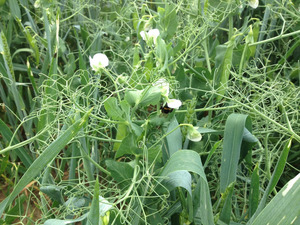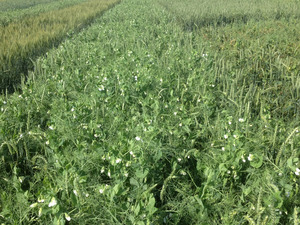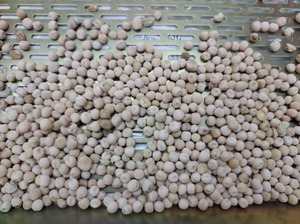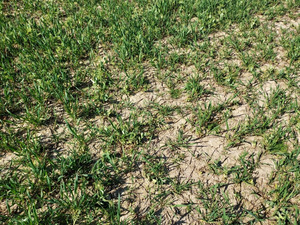Case study 17: Belgium: Grain legumes intercropping with cereals
Cluster 4: Diversification through intercropping, with a special focus on grain legumes
The goal of the case study is to decrease the import of legumes by increasing legume production in Belgium. Increased legume production also has other advantages, such as diversification and reducing the use of chemical nitrogen fertilizers. Improved protein content in wheat when intercropping with pea is also a component in the decision to work with intercropping.
At the agronomic level, it is well established that intercropping with winter pea and winter wheat is working well. The focus now lies on creating added value in the value chain for this sustainable way to produce legumes and grains.







What were the main problems underlying the emergence of the case study?
There is a notable lack of protein production in Europe, making countries like Belgium highly dependent on imports. Nevertheless, due to the changing, humid climate and the lack of sunshine in Belgium, it is still difficult to grow protein crops in large-scale farming. Profitability of protein crops is hindered by the competitive world prices and the risk of crop loss linked to climatic events, which are becoming more and more frequent with the climate change. Therefore, growing a combination of pea and wheat at our latitude enables farmers to produce protein crops (peas) while decreasing the risks. The win-win combination decreases the agronomic problems of the pea while securing a stable economic yield from wheat and making wheat production more sustainable.
How was the problem addressed and which actors were involved?
In this case study, the intention is to focus on scaling up the production by promoting it among the farmers as well as creating added-value in the value chain. We identified the consumers’ willingness to pay for ecosystem services as a major way to create this added-value. Walagri has been working with different farmer’s groups and with food companies and a retailer to reach these goals.
Walagri has also worked with Gembloux Agro-Bio Tech at the University of Liège, in field experiments since 2012 and has undergone farmer’s field tests since 2016 to assess intercropping of winter pea and winter wheat.
We also work with non-profit organisations in order to broaden our knowledge of the varieties and the different technical possibilities.
Solution investigated
To enhance the value of this crop, two major approaches are investigated. The first is to gain knowledge of the crop to provide farmers with the best techniques. To do this, we pay close attention to the new varieties put on the market each year. In addition, we are always looking for new ways to promote the crop such as providing mechanical weeding for better weed control. The second approach is more focused on adding value to the production: We are constantly looking for new outlets to promote these high-quality proteins.
To promote and continue to develop diversification, there are three approaches: Proof of concept for sustainable wheat flour for bread baking, demonstrating the sustainability of the crop in numbers and more efficient logistics and operations.
The new CAP also offers opportunities to promote pea/wheat growing. Indeed, the amounts of subsidies given to farmers in Flanders and Wallonia will be increased for legume crops. This last point will allow pea/wheat cultivation to be adapted more and more by farmers.
Together with DiverIMPACTS partners (workpackage 5), we evaluated:
- different ways to improve the dissemination of information to increase the quantity of wheat/pea production in Belgium
- the economic strategy and how to compare this crop with pure wheat, given that the crop brings environmental or agronomic benefits without reducing profitability
- the approval of the contracts among farmers in order to understand what their feelings or opinions were on the contracts.
With partners in workpackage 4, we calculated the differences in flows and environmental impacts between pea/wheat intercropping and the two crops grown separately. Through the life cycle assessment, we were able to observe much more sustainable environmental trends with intercropping.
Expected outcome
The two main goals of this case study are to increase legume production in Belgium and increase the added-value of the agricultural products in low-input systems.
Relevance to the DiverIMPACTS goals?
One important goal is to be a part of the network to develop interactions and to get in close contact with other case studies with a similar focus to acquire knowledge and evaluate other intercropping possibilities.
Case study legacy
Our objective for the future is to promote pea/wheat production as an alternative to traditional wheat production, but above all to integrate this combination into a value chain. We are still working on adding value to wheat. We have high ambitions for the number of hectares to be planted in the next five years and we would like to reach one thousand hectares as soon as possible. In addition, we aim to implement pea/wheat contracts in our northern French subsidiaries and also in northern Belgium.
Further information
Links
The case study was presented during the DiverIMPACTS final conference. Find out more in the following video (starting at 10:13):
- youtube.com: Session 2 - Barriers to crop diversification all along the value chain and how to overcome them
Case study team
- Benoît Gillain, Wal.Agri, case study leader
- Daniel Jamar, CRA-W, case study monitor
 tap and then scroll down to the Add to Home Screen command.
tap and then scroll down to the Add to Home Screen command.